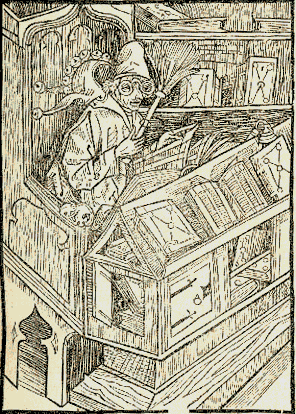Spectacles
Today, thoughts on books and early eyeglasses. The University of Houston's College of Engineering presents this series about the machines that make our civilization run, and the people whose ingenuity created them.
I spent the summer of 1956 hunched over a drawing board. By July I was feeling steady nausea. It turned out I had some astigmatism and needed my first pair of glasses. That took some getting used to. Now, 38 years later, I feel undressed without them.
Those first glasses seemed so modern! I didn't realize spectacles had been around for 700 years. Historian John Dreyfus goes looking for their origins. He finds the first reference to glasses in the transcript of a sermon preached in Florence in 1306:
It is not yet twenty years since there was found the art of making eyeglasses ... So short a time is it ... I have seen the man who ... created it and ... talked with him.
He didn't give the inventor's name, but he did give us a clean date of origin. The first glasses were made just after AD 1286.
An Arab scientist had figured out how to make a spherical lens back in 1036. When his writings reached Europe in 1266, Roger Bacon asked if lenses might help old people with weak eyes. Twenty years later, this Italian inventor managed the trick.
Now the plot thickens. In 1286 people thought our eyes sent out rays that bounced off the things we saw, back into the eye. Theologians thought sight worked a little like radar. We were told to view God's world directly, without the distortion of mirrors and glass. Surely the outgoing and returning rays would be bent by spectacles, and truth would be distorted.
But utility won out. By 1300 Venetian crystal workers were in the eyeglass business. Their best lenses were ground from quartz crystal. Cheaper lenses were made from glass. Those fancy lenses made such a lucrative trade that crystal workers weren't allowed to leave Venice once they'd joined the guild.
Those early glasses either pinched the nose or were held on a stick. Uncomfortable either way, but no matter! Handwritten book production had been skyrocketing for 200 years by then. Now spectacles would further drive that demand.
Two generations later we'd reach the point where Gutenberg would simply have to invent the printing press. And the widespread use of eyeglasses made it possible to start reducing the size of books. More words could be squeezed on a page. The cost of books dropped, and sales kept rising.
In 1494 Sebastian Brant wrote the original Ship of Fools book. In it, Brant shows us a foolish scholar, surrounded by too many books. The fellow uses a feather duster to whip through pages faster than he can read them. He looks like an owl in his oversized spectacles. And so, I suppose, do we, armed as we are with our eyeglasses -- flipping through more words than we can digest -- seven centuries later.
I'm John Lienhard, at the University of Houston, where we're interested in the way inventive minds work.
(Theme music)
Dreyfus, J., The Invention of Spectacles and the Advent of Printing. Into Print: Selected Writings on Printing History, Typography and Book Production, London: The British Library, 1994, pp. 298-310.
I am grateful to Pat Bozeman, Head of Special Collections, UH Libraries, for suggesting the topic and providing the Dreyfus source. The image below is from Brant's book, courtesy of UH Special Collections.
